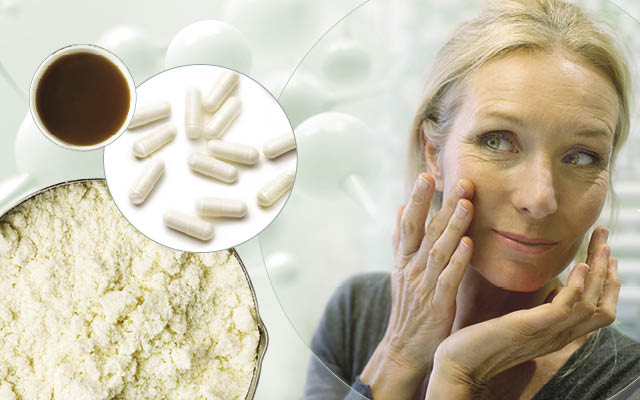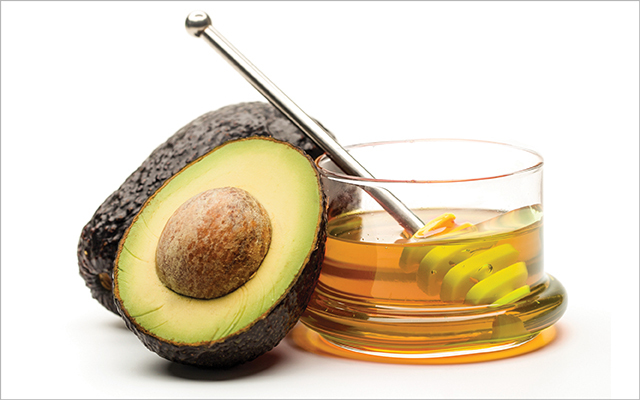Collagen may be best known for its role in keeping skin firm, yet as the most abundant protein in the body, it also does a whole lot more. Studies suggest its amino acids can help reduce joint pain and other arthritis symptoms, protect the delicate lining of the gastrointestinal tract, and even promote healthy sleep.
“Collagen is an important part of the body, especially with conditions we become concerned about as we get older — things like decreasing bone density and joint health, and arthritis,” says functional physician Susan Blum, MD, MPH, founder of the Blum Center for Health in Rye Brook, N.Y.
Our collagen stores decline naturally as we age, however, and certain environmental factors, like stress and toxic exposures, can further slow its production. This may lead to a host of unwelcome issues — stiff joints, sagging skin, and the creeping onset of arthritis symptoms.
As mainstream knowledge of collagen’s benefits has grown in recent years (especially its connection to gut health), the popularity of supplements has also surged: Collagen powders now crowd the shelves at natural-food markets, and bone broth (an excellent whole-food source) has begun appearing on health-conscious restaurant menus.
As is often the case with “new” health products, the risk that collagen marketers promise too much looms large. But health experts generally agree that the protein is essential to our overall health, even as they sometimes disagree about how much we need, the best sources, and how to most effectively support its production in our bodies.
Read on to learn more about this vital — if sometimes vexing — protein.
Why Collagen Matters
Collagen protein is a central component of the body’s connective tissues, including skin, tendons, and ligaments. It’s also found between the spinal discs and in bones, muscles, fascia, cartilage, blood vessels, the gut, and even the corneas.
Its amino acids — especially glycine — offer powerful health benefits. Studies have connected the amino acids to improved immunity, tissue resilience, protein synthesis, and wound healing, as well as increased antioxidant activity. Glycine, specifically, has also been shown to reduce the risk of developing several chronic conditions, including obesity and type 2 diabetes.
“People typically focus on how collagen supplements make your skin beautiful, and obviously that’s a big deal,” says Kellyann Petrucci, MS, ND, author of Dr. Kellyann’s Bone Broth Diet. “But collagen is also a powerful inflammation fighter because it is loaded with anti-inflammatory glycine — and we now know that reducing chronic inflammation is the biggest key to preventing chronic conditions.”
Collagen contains other stand-out amino acids as well. Proline, for example, supports skin health and wound healing, while hydroxyproline (which the body makes from proline) strengthens connective joint tissue.
The Collagen Process
Because collagen production wanes as we get older, health experts often recommend more collagen-rich foods and supplements to offset any effects. But there’s some debate about how much these interventions help.
“Some studies might suggest that eating collagen increases collagen in the skin by a certain amount,” says functional physician Thomas Sult, MD, of the 3rd Opinion clinic in New London, Minn. “But was collagen really rebuilt in the skin?”
When we eat collagen, he explains, digestive enzymes break it down into single amino acids and small peptides. The body absorbs them, at which point they may be repurposed back into collagen — or not.
“Is there soft evidence that eating collagen may help restore collagen? Yes. Is it conclusive evidence? No,” Sult says.
But other research suggests supplemental collagen may help ease symptoms of rheumatoid arthritis (RA) without the side effects of conventional drugs. In a study of 228 patients with RA who received either a placebo or one of four differently sized doses of oral collagen, researchers found that participants experienced positive results from even the lowest collagen dose.
And considering the many factors that can accelerate collagen degradation — such as overexposure to the sun, environmental toxins, sugar, and stress — there are plenty of reasons to add a moderate dose of collagen to your diet, notes Trevor Cates, ND, author of Clean Skin From Within.
How to Get More Collagen
“It’s crucial to enhance your body’s own production of collagen,” says Petrucci. She recommends whole foods first and supplements second. Certain fare helps stimulate collagen production, and specific nutrients — including vitamin C — are necessary for this process.
Whole Meats
Because collagen comes from animal tissue, one might assume eating more meat will help. Yet much depends on the type of meat.
Certain cuts, including roasts, sausage, and skin-on chicken, contain connective tissue rich in collagen. Simply opting to eat whole, bone-in chicken with the skin on, for instance, is an easy way to incorporate more collagen into a meal.
Most of us eat primarily lean muscle meat, says nutritionist Samantha McKinney-Bielawski, RD, LD. But when we eat skinless, boneless chicken breasts, for example, we lose the connective tissue and the collagen that’s present in skin-on meats cooked with the bone.
Skinless, boneless muscle meats pose other problems as well. They are high in methionine, an amino acid that raises homocysteine levels, which research has linked to an increased risk of metabolic disorders, chronic inflammatory conditions (including cancer and cardiovascular disease), and accelerated aging.
Our ancestors, who ate more parts of the animal, tended to avoid these health issues, possibly because eating bone-in meats and other collagen-rich animal tissues helped mitigate methionine’s negative effects, thanks to the glycine.
Meanwhile, pescetarians are in good shape. Fish broth and canned salmon are prime sources of collagen. Fresh wild-caught salmon contains plenty of zinc, which activates the proteins needed for collagen synthesis. Cod, mackerel, and other types of whitefish are loaded with glycine and proline.
Bone Broth
“Drinking bone broth is an excellent way to supply your body with collagen and its building blocks,” says Petrucci.
Making your own bone broth requires patience but little else. All you need are bones (chicken, beef, or fish), some apple-cider vinegar to help pull gelatin from the bones, and whatever vegetables you like. Put all the ingredients into a large stockpot or slow cooker and simmer for 24 to 48 hours. (For a recipe, see How to Make Bone Broth.)
When choosing bones, opt for grassfed, organic livestock sources or wild-caught fish. This is especially important because any toxins the animal harbors will be concentrated in the long-simmered liquid.
Most natural markets now carry premade packaged bone broth, but shelf-stable brands tend to offer less collagen than homemade versions, because manufacturers typically cook the broth at higher temperatures for shorter durations. Look for freshly made collagen-rich broths in the refrigerated or freezer section when you can’t make your own. (Note: Broth containing plenty of collagen thickens when it cools. If it stays clear and thin, it’s lacking.)
Plant-Based Collagen Boosters
Vegetarians and vegans can choose from a variety of plant-derived compounds that deliver benefits similar to those of collagen.
L-glutamine, for example, addresses gastrointestinal issues. You can find it in red cabbage, asparagus, broccoli raab, and other whole foods, or take it as a supplement. In fact, Sult considers L-glutamine even more powerful than collagen for healing intestinal permeability.
Petrucci recommends emphasizing the following foods, which contain plentiful amounts of the amino acids that make collagen so beneficial:
- Glycine-rich foods, including bananas, beans, cabbage, cauliflower, kale, kiwi, pumpkin, and spinach.
- Proline-rich foods, such as asparagus, beans, buckwheat, cabbage, cucumber, chives, mushrooms, seaweed, spinach, and watercress.
This originally appeared as “The Collagen Connection” in the March 2019 print issue of Experience Life.
Help Collagen Help You
Your body needs specific nutrients to produce its own collagen. The following are essential for revving up production.
- Vitamin C helps link specific amino acids together to build collagen. In addition to citrus, vitamin-C-rich foods include broccoli, kale, chili peppers, Brussels sprouts, strawberries, and parsley.
- Sulfur is critical to collagen formation, says Kellyann Petrucci, MS, ND. Ideal foods include garlic, onions, leeks, eggs, broccoli, cauliflower, Brussels sprouts, and cabbage. Garlic is a collagen-supporting superstar because it’s rich in sulfur and contains taurine and lipoic acid, both of which help repair damaged collagen.
- Zinc and copper aid collagen synthesis. Foods high in zinc include pastured lamb, nuts, pumpkin, and pumpkin seeds. Sunflower seeds and shellfish are good sources of copper. Oysters and cacao powder contain both copper and zinc.
- Lysine is an amino acid required for collagen synthesis, Petrucci notes. Key sources of lysine are black beans, lentils, pistachios, pumpkin seeds, tempeh, and quinoa.
|
Supplemental Collagen
While views differ about the effectiveness of powdered collagen supplements, most experts agree they can’t hurt.
“I believe in food first,” says Susan Blum, MD, MPH. “But by taking collagen powders you will get even more of the amino acids that may help you make your own collagen.”
Powdered supplements are also easy to integrate into your diet; they have a mild flavor that most people don’t notice blended into smoothies or coffee.
They are also a highly digestible, assimilable form of protein. “For people with weak digestion, where it is harder for them to get the nutrition out of food, collagen powder is one step closer to being digestible,” Blum explains.
If you opt for a supplement, make sure it doesn’t contain sugar or chemical sweeteners, and avoid making it your only protein powder. The amino acids in collagen powder are supportive, but they’re not complete. “There is no tryptophan in collagen, for example,” says Blum. “So collagen won’t support mood. Protein supplements are best when rotated.”|
Decoding Supplement Labels
Learn how to decipher some of the terms you’ll encounter on supplement labels:
- Gelatin: When collagen is cooked down to make it more digestible, it produces gelatin. Gelatin is collagen, just in a cooked and easier-to- absorb form (it is considered partially hydrolyzed or broken down). Gelatin thickens when it cools. You can use grassfed, sugar- and additive-free varieties of gelatin to make a healthy version of the boxed- gelatin treats of your youth.
- Hydrolyzed collagen: This form of collagen is broken down even further into its component parts than gelatin, making it even easier for the body to absorb. Hydrolyzed collagen can be dissolved in hot or cold water (gelatin must be dissolved in warm water), and it does not thicken when it cools.
- Peptides: This is just another word to indicate that the collagen has been separated into its various components so it is easier to absorb. It is often used interchangeably with “hydrolyzed collagen.”




This Post Has 0 Comments